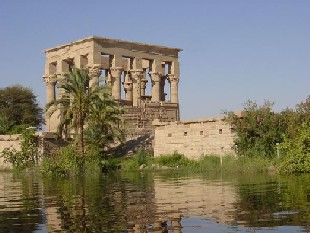|
The Temple of Isis
The Temple of Isis of the Ptolemaic Period, which was
originally located on the island of Philae, now dominates the
island of Agilkia. After the construction of the Aswan Dam
(1898-1912), the island of Philae was completely out of the
water only from August through December. The waters controlled
by the High Dam (completed in 1971) would have covered it.
Therefore, the temple was moved in the late 1960s, but it is
still known as Philae Temple. As tourist boats approach the
island of Agilkia from the east, Trajanís Kiosk (left) balances
the Temple of Isis (right). The layout of the temple is apparent
from this vantage point: from the left, first pylon, open court,
second pylon, covered hypostyle hall, sanctuary |
 |
|
Ptolemaic Temple of Isis
This view of the Ptolemaic Temple of Isis (Philae Temple)
is from the west and illustrates well the Egyptian use of the
post and lintel system of construction. This view also
demonstrates the layout of the temple: from the right, first
pylon, open court, second pylon, covered hypostle hall,
sanctuary.
In 1958, Gamel Abdel Nasser, president of Egypt, decided to
build a high dam at Aswan. The Egyptians wanted it to control
the flooding of the Nile and to generate electrical power for
themselves. Unfortunately the lake created by the dam would
completely flood Lower Nubia and destroy all of the ancient
Nubian sites in Egypt. The waters would also inundate about 70
miles (110 km) of the Sudan. Because of the building of the dam,
a huge international emergency effort was organized to rescue
Nubia's archaeological treasures and heritage before they were
lost forever. Thus, between 1959 and 1967, over 40 international
teams worked together to explore 300 miles of the Nile Valley.
They discovered thousands of ancient sites and objects, which
are now in museums the world over. Three complete Nubian temples
were removed altogether and may now be seen in New York
(Metropolitan Museum of Art), in Leiden, Holland (Museum van der
Oudheden), and in Barcelona, Spain. Many others were taken down
and restored on higher ground. This great effort made Lower
Nubia, archaeologically, one of the best known regions of the
world and created the discipline of "Nubiology." After the
flooding of Lower Nubia and with the passage of time, many of
the Nubiologists in the 1970's began to look south to continue
their researches.
The Nubia salvage project
The oriental institute participated in the UNESCO
international salvage excavation project in the reservoir area
of the Aswan High Dam in Upper Egypt in 1960-64. The project was
directed by Keith Seele, Professor of Egyptology at the
Institute. The expedition was based on the former Cook tourist
boat "Fostat", accompanied by another houseboat, a tug boat, and
a motor launch, all purchased and modified to provide mobile
housing, laboratories and storage space. In the first season the
project produced an epigraphic record of the Beit El-Wali
Temple, near the High Dam. In subsequent seasons the expedition
moved its little fleet up the Nile to a new concession between
the temples at Abu Simbel and the border of the Sudanese
Republic. Excavations were conducted in a monastery, at
habitation sites, and in a number of cemeteries extending for
miles along both banks of the Nile. These excavations
contributed information on every period of Egyptian Nubia from
the Old Kingdom through Coptic times.
After the death of Professor Seele in 1971, the Institute
initiated a project to complete the publication of the results
of the Egyptian Nubia excavations. The publication project was
entrusted to Bruce Williams, Ph.D., a graduate of the University
of Chicago in Egyptology. The first two volumes were published
before Williams was assigned to the project. Since then Williams
has completed eight monumental monographs (1986-93) that will
stand as the fundamental sources for the archaeology and history
of Egyptian Nubia. Williams is currently working on two
additional volumes. Another two volumes are also in preparation
by collaborators, including one Ph.D. dissertation. Williams has
devoted his entire academic career to the Nubia publications.
His dedication is admirable and the Institute takes pride in the
fact that the Nubia publication project is near completion.
Because the Nubian expedition was a part of the UNESCO salvage
project, the Egyptian Government granted export license for a
large collection of objects recovered by the expedition. These
artifacts are now a part of the permanent collection of the
Institute and will serve as a valuable resource for generations
of scholars as new questions are raised and new techniques of
analysis are introduced. Two museum exhibitions of Nubian
materials from the collection have been mounted; one of
magnificent textiles at the Art Institute, and a fine
educational exhibition in the Oriental Institute Museum. The
exhibit in our museum, Vanished Kingdoms of the Nile: The
Recovery of Ancient Nubia, attracted many enthusiastic new
visitors to the museum and received a "Superior Achievement"
award from the Congress of Illinois Historical Societies and
Museums in 1992, as well as considerable press coverage,
including a favorable review in the New York Times.
|